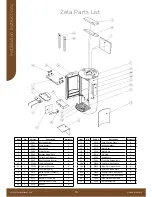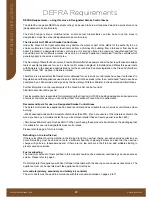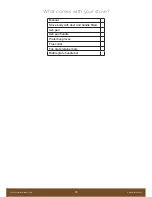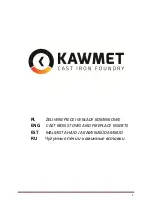
Zeta 5W Series Manual - V2.8
© Oak Stoves 2018
12
Troubleshooting
Fire will not burn
Check that:
• the air inlets are obstruction free
• chimneys and flueways are clear.
• you are using a suitable fuel.
• an adequate air supply is entering the room.
• an extractor fan is not fitted in the same room as the stove.
• the chimney has a sufficient draw. A draught reading of at least 2.5mm water gauge
should be seen (
once the chimney is warm
).
Door glass blacks up
Because chimneys differ greatly the best draught settings will take a few trials to figure out,
but the following tips should help:
• When re-fuelling place the fuel towards the back of the firebox, keeping it as possible
from the front grill and avoid over filling.
• The primary air vent on the door may be kept slightly open to assist in keeping the
glass clean or open up the secondary and tertiary slider bar further.
• Unseasoned wood will cause more deposits on the glass if the moisture level is more
than 20%.
Bear in mind it tends to be more difficult to keep the glass panel clean if you’re running the
stove very slowly for a long period of time. If blackening of the glass still occurs ensure that
all flue connections are well sealed with fire cement, as this can decay over a long period of
time and may need resealing. Also the chimney draw needs to be sufficient and not affected
by down-draught.
When certain smokeless fuels you may notice some blackening of the glass below the
grill level, this is to be expected and shouldn’t obscure your view of the fire or affect the
performance of the stove.
Fume emission
IMPORTANT:
If this appliance is properly installed and operated it will not emit fumes.
Occasional fumes when de-ashing or re-fuelling are to be expected, but fumes during normal
use are NOT usual. Persistent fume emission can be very dangerous and should NOT be
ignored. If you notice persistent fume emission you should immediately:
• Open all doors and windows in order to ventilate the room.
• Let the fire go out and safely dispose of the remaining fuel from the appliance.
• Check for any blockage to the flue or chimney and clean if required.
• DO NOT attempt to re-light the fire until the cause of the fumes has been identified
and resolved. Seek professional advice if necessary.
The most likely cause of fume emission would be due to flue or chimney blockages. For your
own safety it is vital that you regularly check and clean your flue and chimney.
Oper
a
ting Ins
tructions










































